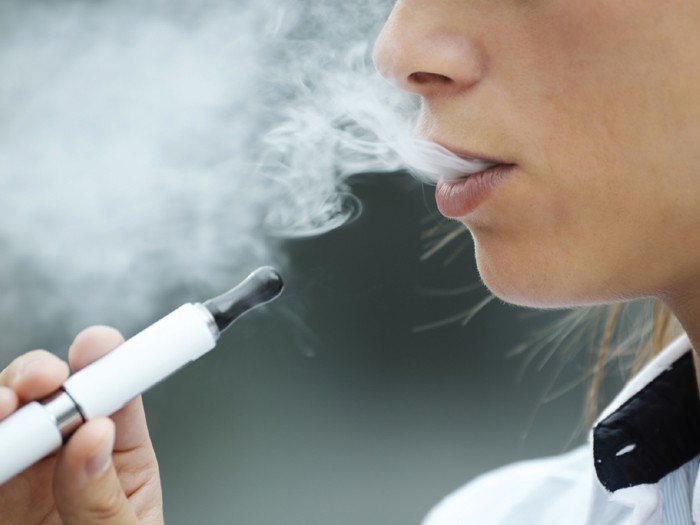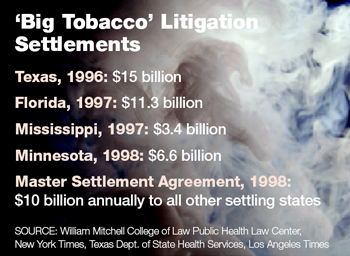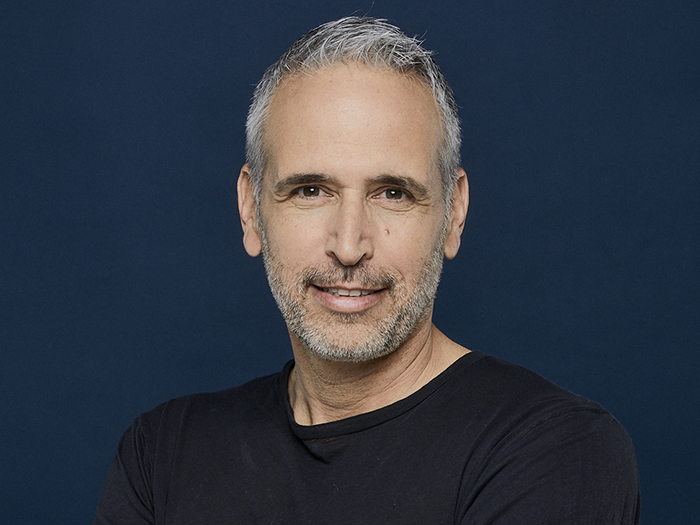2015 Most Dangerous Emerging Risks
Vaping: Smoking Gun

SCENARIO: It’s 2040, and there were not quite as many attendees of the 25-year high school reunion party as expected. Gossip begins to circulate just as it did around the cafeteria and corridors a couple of decades earlier.
“Is John coming tonight?” one man asked an ex-classmate.
“No, didn’t you hear? He’s in the middle of chemo treatments right now,” she responded solemnly. “Esophageal cancer.”
“Hey Kelly!” another alumnus shouted. “I don’t think I’ve seen you since Nationals senior year. How are you? Still running?”
Kelly was a standout miler on her high school and university track teams, known for her strong finishing kick.
“No,” she responded, exhaling a cloud of raspberry-flavored vapor as she lowered her still-glowing e-cigarette.
“I haven’t been able to run much lately, not without an inhaler, anyway. Developed asthma a few years ago.”
In 2015, when this group was graduating, “vaping” was the latest and greatest trend. It delivered the soothing effects of nicotine without the carcinogens of tobacco smoke, tasted much better, and there were no age restriction laws.
The litigants claim their health issues stem directly from the dubious concoction of chemicals in the e-liquid his company imported from China and sold in their branded vape pens.
E-cigarette advocates predicted that vaping would dramatically decrease the rates of lung cancer and other smoking-related diseases. But 25 years later, the effects of the e-liquid’s various chemicals and concentrated nicotine are clear. Rates of lung cancer, which had been decreasing steadily in the U.S., are rising again, along with heart disease and other types of cancer.
That same night, the CEO of a national e-cigarette distributor is staring at a subpoena. His company is being sued by the families of a few hundred of his most loyal customers who have developed respiratory and heart problems.
In fact, a recent longitudinal study of “vapers” by the Centers for Disease Control and Prevention found strong positive correlations between high use of e-cigarettes and incidence of heart disease and cancers of the respiratory system.
The litigants claim their health issues stem directly from the dubious concoction of chemicals in the e-liquid his company imported from China and sold in their branded vape pens.
Tests of several batches of the liquid by the FDA revealed inconsistent concentrations of nicotine, propylene glycol, and other flavor additives and preservatives. The levels of nicotine found in the vapor were also inconsistent with the label.
The class-action litigants were seeking punitive damages totaling $20 billion, half of which would be used to create a medical treatment fund. The number is staggering, but not out of line with some of the lawsuits that emerged against “Big Tobacco” companies in the late 1990s, the highest of which sought damages of $23.6 billion. Other smaller distributors had already been knocked out by smaller settlements, still in the millions.
The CEO had already talked to his broker. The contractual protection they had in place pinned product liability to the manufacturer, based in Shanghai, but did not address risks of long-term health effects. That liability was all theirs.
ANALYSIS: In 2015, the retail vaping industry is forecast to reach $3.5 billion, more than twice the $1.7 billion estimated for 2013, according a Wells Fargo Securities report on tobacco trends in the U.S.
E-cigarettes, which deliver a nicotine hit without tobacco combustion — and the carcinogens that come with it — attract customers from the traditional cigarette market looking for a healthier or safer alternative to their smoking habit, and from the youth market, drawn to the sleek styling and fun flavors of vaporizers, as well as the claim that they are far less dangerous than combustible cigs.
According to the CDC’s National Youth Tobacco Survey, “the number of never-smoking youth who used e-cigarettes increased from 79,000 in 2011 to more than 263,000 in 2013.”
According to “Monitoring the Future,” a study from the University of Michigan analyzing drug and tobacco trends among teens, there were twice as many e-cig users than smokers of combustible cigarettes among eighth, 10th and 12th graders. Sixty-two percent of eighth graders surveyed said that cigarettes are very harmful to health, while only 15 percent reported feeling that way about e-cigarettes.
And there is basis for these beliefs. Studies of e-vapors show that the amounts of toxic chemicals they contain are negligible, compared to traditional cigarettes, and their concentrations are nearly equal to those already present in the air we breathe. Many public health advocates laud e-cigs as a long-term tool to reduce smoking rates and the respiratory illnesses that come with it.
“There’s no question that e-cigarettes are much safer,” said Michael Siegel, a professor at Boston University’s School of Public Health.
“The risks are minimal, compared to tobacco smoking.”
But the danger in any new product lies in the unknown. Vapors produced from e-liquids may not be as harmful as smoke, but the composition of those liquids varies widely.
“A lot of these devices are made in countries that struggle with quality issues in the manufacturing process,” said Mark Wood, president and CEO of LifeScienceRisk, a subsidiary of RSG Underwriting Managers.
“When using foreign contract manufacturers, you don’t always know who exactly is making the product.”
Inconsistent manufacturing leads to variability in nicotine levels. Byproducts of the manufacturing process, flavoring and other preservatives also potentially introduce other carcinogens into the mix. But the final composition is largely unknown.
Adverse health effects of those unknown chemical mixtures could range from allergic reactions to cancer.
The heating element of e-cigarettes also poses a threat. If it gets too hot, it can “trigger a thermal breakdown” of the materials used to make the e-cig, creating carbonyls like formaldehyde and acetaldehyde. These compounds are delivered in nano-sized particles directly into the airways, where they trigger inflammation that can lead to the development of chronic conditions.
Little clinical research has been conducted on the safety of these vapors, and the long-term health effects may not be seen for another 20-30 years.
“From the FDA’s point of view, they’re waiting to see if e-cigarettes can reduce the number of smoking deaths. They want to see the whole picture before they take a firm stance on the issue,” said Markus Kalin, head of casualty risk engineering at XL Group.
Another problem is the lack of age restrictions, coupled with flavorings like cherry vanilla and blue raspberry, which make these products highly appealing to those under 18.
In a customer base that has never or rarely smoked traditional cigarettes, long-term use of e-cigarettes could increase, rather than reduce, the likelihood of health issues.
“The purpose of e-cigarettes is to get people off smoking in a safer way. They are not absolutely safe,” Siegel said.
Current high-school vapers could be in their 40s or 50s before any ill effects emerge. It may not be lung cancer or emphysema, but perhaps higher rates of asthma, bronchitis, cystic fibrosis or other inflammatory pulmonary diseases.
And distributors of vaping products could be held liable, in much the same way tobacco companies faced massive lawsuits after smoking was definitively linked to lung cancer.
The fact that most e-cigarette manufacturers are based in China also “puts distributors and retailers in the U.S. at higher risk,” said Randy Nornes, executive vice president at Aon Risk Solutions.
“If you’re the only link between a non-U.S. manufacturer and the customer, you’re an obvious target for plaintiffs.”
Wood said that distributors “can subrogate that claim against a contract manufacturer or supplier, but it’s more difficult to do that against an entity in a different country subject to different laws.”
Given the huge settlements with tobacco companies, plaintiffs’ attorneys will be more than willing to take on the e-cigarette industry.
“They look for market opportunities,” Nornes said, “anything that potentially has harm in it and involves a lot of people.”
Vaping distributors could face product liability suits for improper labeling of e-liquid cartridges or false advertising concerning its health benefits. Kalin of XL Group said parents of e-cigarette users could pursue advertising litigation against distributors for failure to protect young people.
“But the next stage will be, if you start to see health issues emerge and more studies trickling out, and younger people developing diseases like lung cancer, that will be the catalyst for mass tort,” Nornes said.
E-cigarette distributors and retailers need proactive risk management, experts said.
“You really have to understand your supply chain,” said Aaron Ammar, risk manager at XL Group. “Make sure you have appropriate age restrictions and proper labeling about potential health effects. Where are the component parts coming from? Do you understand it?”
“I’m sure they’re all doing contractual risk management, to make sure risk stays with the manufacturer,” Nornes said.
“The second issue is making sure the manufacturer has adequate levels of insurance in the event you get sued for distributing someone else’s product. That’s where issues will creep in, because you’re relying on a third party’s insurance.”
Complete coverage of 2015’s Most Dangerous Emerging Risks:
 Corporate Privacy: Nowhere to Hide. Rapid advances in technology are ushering in an era of hyper-transparency.
Corporate Privacy: Nowhere to Hide. Rapid advances in technology are ushering in an era of hyper-transparency.
 Implantable Devices: Medical Devices Open to Cyber Threats. The threat of hacking implantable defibrillators and other devices is growing.
Implantable Devices: Medical Devices Open to Cyber Threats. The threat of hacking implantable defibrillators and other devices is growing.
 Athletic Head Injuries: An Increasing Liability. Liability for brain injury and disease isn’t limited to professional sports organizations.
Athletic Head Injuries: An Increasing Liability. Liability for brain injury and disease isn’t limited to professional sports organizations.
 Vaping: Smoking Gun. As e-cigarette usage rises, danger lies in the lack of regulations and unknown long-term health effects.
Vaping: Smoking Gun. As e-cigarette usage rises, danger lies in the lack of regulations and unknown long-term health effects.
Aquifer: Nothing in the Bank. Once we deplete our aquifers, there is nothing helping us get through extended droughts.
Most Dangerous Emerging Risks: A Look Back. Each year since 2011, we identified and reported on the Most Dangerous Emerging Risks. Here’s how we did on some of them.














